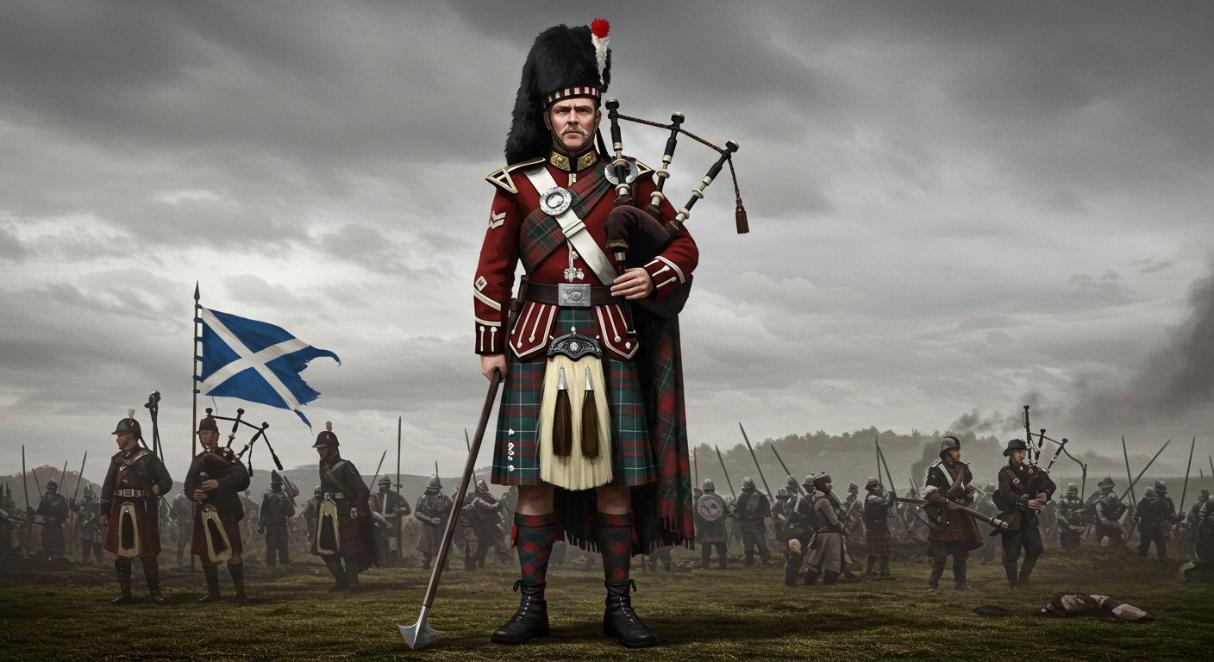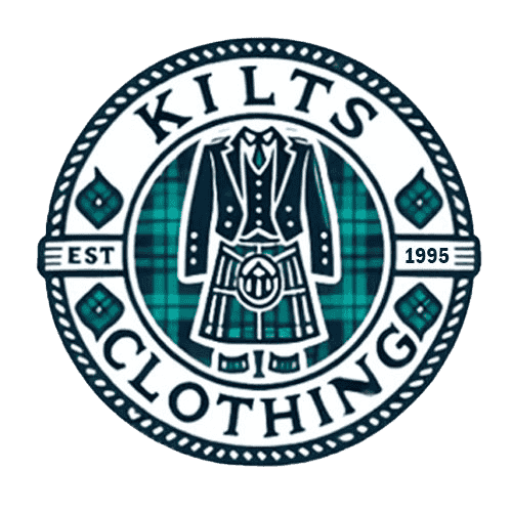- Mens Utility Kilt Collection
- Tartan Kilts Collection
- Best Hybrid Kilt Collection
- Leather Kilts
- Denim Kilts Womens
- Casual Kilt
- Formal Kilt
- Irish Kilt
- Kilt Vest
- Scottish Kilt
- Sport Kilts for Men – Durable & Comfortable
- Tactical Kilt – Durable Multicam Kilt for Men
- Wedding Kilt
- Firefighter Kilt
- Flag Kilts
- Military Kilt
The Role of the Kilt in Scottish Military History
On February 4, 2025
Comments Off on The Role of the Kilt in Scottish Military History

The kilt is one of the most recognizable symbols of Scottish heritage. Its association with Scottish identity is undeniable, and its historical significance goes far beyond its use as traditional Highland attire. The Scottish kilt played an essential role in Scotland's military history, from its early use in battles to its continued presence in modern military regiments. In this article, we will explore the kilt's importance in Scottish military history, tracing its evolution from a practical garment to a symbol of national pride.
The Origins of the Kilt in Scottish Military Culture
The kilt's roots can be traced back to the ancient Celtic garments worn in the Scottish Highlands. The early form of the kilt, known as the féileadh mór (great kilt), was a large piece of cloth wrapped around the body, providing warmth and mobility. This design was perfect for the Highlands' harsh conditions and the needs of the Highland soldiers, who required practical clothing that could withstand long marches and battles.
The féileadh mór was worn by soldiers and civilians alike and was an essential part of everyday life. The kilt provided flexibility, enabling warriors to move swiftly and efficiently in battle. Its use among Scottish soldiers was not only about practicality but also about identity; wearing the authentic scottish kilt became a mark of pride and a way for soldiers to differentiate themselves from their enemies.
The Kilt and the Jacobite Rebellions
One of the most significant moments in Scottish military history involving the kilt came during the Jacobite Rebellions of the 17th and 18th centuries. The Jacobites, loyal to the exiled Stuart monarchy, sought to restore King James II and his heirs to the British throne. The kilt became a symbol of Scottish resistance and defiance during these uprisings.
In particular, the Battle of Culloden in 1746, the final confrontation between the Jacobites and the British Army, solidified the kilt's association with Scottish military struggles. Many Highland soldiers wore kilts as part of their uniform, symbolizing their loyalty to the Jacobite cause. The British government, after their victory, took drastic measures to suppress Scottish culture, including the kilt.
In 1746, the Act of Proscription was passed, which made wearing kilts and tartan illegal. It was an attempt to eradicate Scottish identity and suppress the military traditions of the Highlands. Despite the ban, the kilt remained a symbol of rebellion and Scottish pride for many years, representing the determination to preserve Scottish heritage and military history.
The Revival of the Kilt in the British Army
Despite the harsh measures taken after the Jacobite Rebellions, the kilt was revived in the British Army in the 19th century. With the formation of Highland regiments, such as the Black Watch and the Gordon Highlanders, the kilt re-entered military life as part of the formal uniform of Scottish soldiers serving in the British Army.
Soldiers in these regiments wore the kilt with pride. They were keen to maintain their Scottish identity while serving in the British Army. Adopting the kilt as part of the uniform also served a strategic purpose, helping distinguish Scottish soldiers from other troops. It became a symbol of both loyalty to the British crown and pride in Scottish heritage. As these regiments fought in battles across the globe, the kilt became a powerful emblem of Scottish bravery and military tradition.
Kilts in the Napoleonic Wars and Beyond
The early 19th century saw Scottish regiments in the British Army playing an essential role in key military campaigns, including the Napoleonic Wars. At the Battle of Waterloo in 1815, Scottish regiments wore their distinctive kilts as part of their uniform, further cementing the kilt's association with military valor.
The military use of the kilt was not limited to the Napoleonic Wars. It continued to be worn by Scottish soldiers in various conflicts, including the Crimean War, World War I, and World War II. In both World Wars, Scottish kilts for sale became a symbol of the Scottish contribution to the war effort, and soldiers from Scotland's regiments proudly wore their kilts in battle, even in the harsh conditions of trench warfare.
Although the kilt was not always practical for the rigors of modern warfare, it remained a vital part of Scottish military tradition, worn during ceremonial duties, parades, and other formal events. The symbolism of the kilt was as crucial as its practicality; it represented the continuity of Scottish military heritage and the enduring spirit of Scotland's soldiers.
The Kilt in Modern Military Regiments
Today, the kilt remains worn in various ceremonial roles within the Scottish military. For example, the Royal Regiment of Scotland maintains the tradition of wearing kilts as part of their regimental uniform. While the kilt is no longer used in combat, it plays a significant role in ceremonial functions, such as military parades, changing guard ceremonies, and state occasions.
The kilt's role in modern military regiments is not just about tradition but also a powerful reminder of Scotland's military history. It connects current soldiers with their forebears, creating a sense of camaraderie and pride. The kilt's continued use in the British Army and other military organizations worldwide reflects the enduring bond between the garment and Scotland's military heritage.
The Kilt as a Symbol of Military Camaraderie
Beyond its role in military service, the kilt has come to represent the camaraderie and identity of Scottish soldiers. The kilt is not merely a piece of clothing but a symbol of shared history and mutual respect. For soldiers in kilted regiments, wearing the kilt fosters a sense of unity, as it is a constant reminder of the sacrifices made by past generations.
Soldiers' pride in wearing the kilt is not just about tradition but also about continuing a legacy. The kilt has become a symbol of the resilience and endurance of Scotland's military forces. This garment links soldiers across centuries and the world.
Controversies and Modern-Day Use of the Kilt
While the kilt remains a beloved symbol of Scottish military history, it has also been debated. Some have questioned its practicality in the modern military as more functional and weather-appropriate uniforms have been introduced. However, the kilt's role in ceremonial duties and as a symbol of Scottish pride remains unquestioned.
Today, the kilt is primarily worn during formal occasions, military ceremonies, and special events such as Remembrance Day services and Highland Games. Despite the controversies over its continued use, the kilt remains an integral part of Scottish military life, symbolizing the past and present of Scotland's military heritage.
Conclusion
The kilt's role in Scottish military history is undeniable. From its early use in the Highlands as a practical garment for soldiers to its symbolic significance in the Jacobite Rebellions, the kilt has stood as a testament to Scotland's military resilience. Over the centuries, the kilt has evolved from a garment worn by Highland warriors to a cherished symbol of Scottish pride, worn by soldiers in regiments such as the Black Watch and the Royal Regiment of Scotland.
Today, the kilt continues to symbolize Scotland's enduring military legacy. While its use in combat may have diminished, its role in ceremonial functions ensures that the kilt remains a proud reminder of Scotland's military history, uniting soldiers and civilians in their pride for Scottish traditions.


